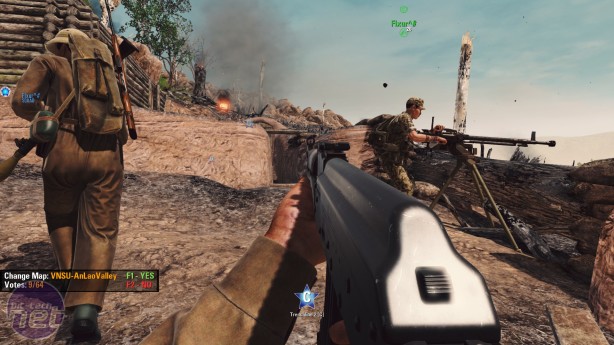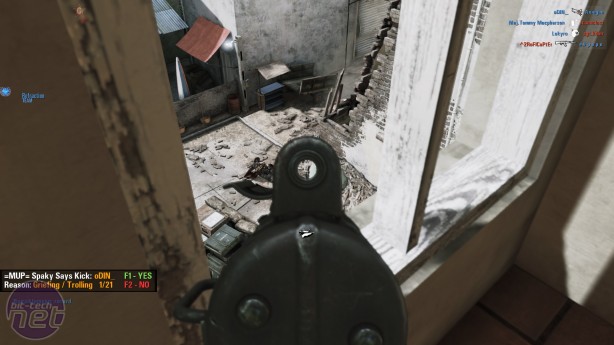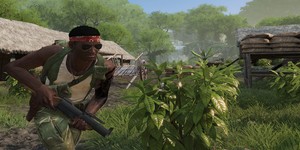
In Territories, the Vietcong are always the defensive force, with players swapping sides halfway through the match. To complement this, the developers have designed several fantastic maps. My favourite is probably Hill 937, which sees the Americans scrambling from dense rainforest lowland towards the Artillery-blasted summit of a mountain, where the NLF headquarters resides.
Clambering this hillside is a terrifying prospect for the Americans, with the NLF dug in like ticks and able to pop up in seemingly random places using their dastardly tunnelling system. Yet although the Vietnamese have the high ground, the Americans can take advantage of generous cover opportunities and use the jungle to flank the first two control points.
The designers excel at constructing maps so that combat scenarios shift as battles progress. Hue City begins with a close-quarters battle in twisting alleyways overlooked by multi-storey buildings. If the Americans capture the control points, the Vietnamese retreat across a narrow bridge to a looming temple, and the Americans must either attempt to cross the bridge or ford the river to capture the next point. Cu-Chi, meanwhile, sets the action in a small town flanked by rice-paddies, before moving to a forest scored by maze-like trenches and finally a fortified factory complex.
I think the map design might be my favourite aspect of Rising Storm 2. The developers do a fantastic job of evoking their theme in the design, and each map dramatically changes how both sides approach combat. However, the size and the complexity of these war arenas means there are only a handful of them. There are five maps for the larger modes (the other mode being Supremacy, a capture-and-hold scenario similar to Battlefield’s Conquest) plus three smaller maps for Skirmish, which is basically deathmatch.
Frankly, given the size of these maps and the low price-tag, I think Rising Storm 2 has an acceptable amount to it. A bigger problem for me is the lack of polish to the combat. On a broader scale, Rising Storm 2 depicts war superbly. The billowing smoke from air strikes and viscous flames of napalm drops are both awesome and horrifying, while each gunshot and grenade echoes across the battlefield in a way that is startlingly realistic. On a smaller scale, Rising Storm 2 is less convincing. Movement and aiming feel a little sluggish, while shooting and bullet impacts don’t have the same physicality to them as in games like Battlefield.
Rising Storm 2 is also quite opaque. The many different roles, each with unique play-styles, tricks, and abilities require considerable time investment to master. Until you do, you’re going to die a lot. Moreover, being a proficient player is no guarantee that you will have a good time. Success in Rising Storm 2 relies largely on a Commander who knows what he is doing and a team that pays attention to his orders.
When all these things come together, it’s a hugely rewarding experience. But when they don’t, it can be frustrating and downright punishing. I’ve played entire games where all I’ve done is run to the front line, die, respawn, and repeat this miserable cycle for 20 minutes. Not because I was playing wrong, but because the other team had a good commander and we didn’t.
In short, I like Rising Storm 2, but I find it difficult to love. It offers a more challenging and tactically rewarding experience to Battlefield without skimping on the scope and spectacle of its combat. But it’s also less consistently enjoyable than DICE’s game, requiring the player to educate themselves appropriately and a specific set of circumstances in order to flourish. When it does flourish, however, it is quite remarkable, and while I doubt I will be returning to it regularly, I don’t regret the time I spent in Tripwire’s depiction of Vietnam.
Clambering this hillside is a terrifying prospect for the Americans, with the NLF dug in like ticks and able to pop up in seemingly random places using their dastardly tunnelling system. Yet although the Vietnamese have the high ground, the Americans can take advantage of generous cover opportunities and use the jungle to flank the first two control points.
The designers excel at constructing maps so that combat scenarios shift as battles progress. Hue City begins with a close-quarters battle in twisting alleyways overlooked by multi-storey buildings. If the Americans capture the control points, the Vietnamese retreat across a narrow bridge to a looming temple, and the Americans must either attempt to cross the bridge or ford the river to capture the next point. Cu-Chi, meanwhile, sets the action in a small town flanked by rice-paddies, before moving to a forest scored by maze-like trenches and finally a fortified factory complex.
I think the map design might be my favourite aspect of Rising Storm 2. The developers do a fantastic job of evoking their theme in the design, and each map dramatically changes how both sides approach combat. However, the size and the complexity of these war arenas means there are only a handful of them. There are five maps for the larger modes (the other mode being Supremacy, a capture-and-hold scenario similar to Battlefield’s Conquest) plus three smaller maps for Skirmish, which is basically deathmatch.
Frankly, given the size of these maps and the low price-tag, I think Rising Storm 2 has an acceptable amount to it. A bigger problem for me is the lack of polish to the combat. On a broader scale, Rising Storm 2 depicts war superbly. The billowing smoke from air strikes and viscous flames of napalm drops are both awesome and horrifying, while each gunshot and grenade echoes across the battlefield in a way that is startlingly realistic. On a smaller scale, Rising Storm 2 is less convincing. Movement and aiming feel a little sluggish, while shooting and bullet impacts don’t have the same physicality to them as in games like Battlefield.
Rising Storm 2 is also quite opaque. The many different roles, each with unique play-styles, tricks, and abilities require considerable time investment to master. Until you do, you’re going to die a lot. Moreover, being a proficient player is no guarantee that you will have a good time. Success in Rising Storm 2 relies largely on a Commander who knows what he is doing and a team that pays attention to his orders.
When all these things come together, it’s a hugely rewarding experience. But when they don’t, it can be frustrating and downright punishing. I’ve played entire games where all I’ve done is run to the front line, die, respawn, and repeat this miserable cycle for 20 minutes. Not because I was playing wrong, but because the other team had a good commander and we didn’t.
In short, I like Rising Storm 2, but I find it difficult to love. It offers a more challenging and tactically rewarding experience to Battlefield without skimping on the scope and spectacle of its combat. But it’s also less consistently enjoyable than DICE’s game, requiring the player to educate themselves appropriately and a specific set of circumstances in order to flourish. When it does flourish, however, it is quite remarkable, and while I doubt I will be returning to it regularly, I don’t regret the time I spent in Tripwire’s depiction of Vietnam.


MSI MPG Velox 100R Chassis Review
October 14 2021 | 15:04













Want to comment? Please log in.